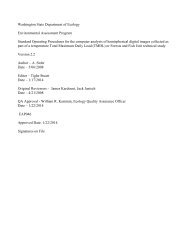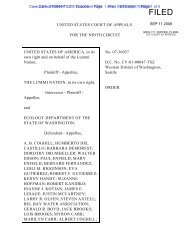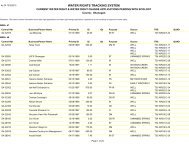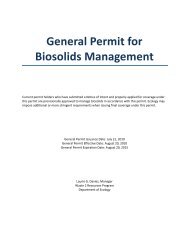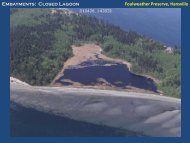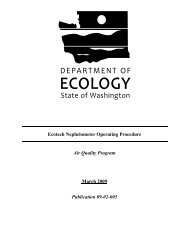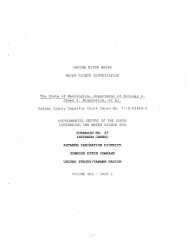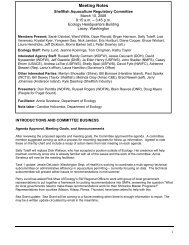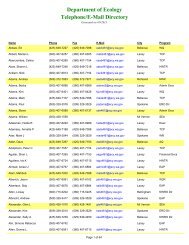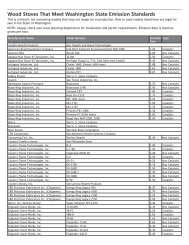WRIA 62 WMP 032305 - Washington State Department of Ecology
WRIA 62 WMP 032305 - Washington State Department of Ecology
WRIA 62 WMP 032305 - Washington State Department of Ecology
You also want an ePaper? Increase the reach of your titles
YUMPU automatically turns print PDFs into web optimized ePapers that Google loves.
March, 2005 -86- 023-1289-003.3040<br />
control releases from Hungry Horse Dam from the winter months to the spring to aid flow<br />
augmentation.<br />
Reservoir operation under VARQ is generally the same as previous operation during big water years.<br />
In lower water years (80%-100% <strong>of</strong> average), the winter drawdown is reduced. This provides for<br />
higher spring flows that are closer to natural conditions.<br />
The Environmental Assessment for VARQ on Hungry Horse Reservoir was completed in December<br />
2002 (ACOE and BOR, 2002) and Hungry Horse Reservoir began operating under VARQ that year.<br />
An Environmental Impact <strong>State</strong>ment is expected to be completed in September 2005.<br />
5.2 Total Maximum Daily Load (TMDL) Development and Implementation in <strong>Washington</strong><br />
and Idaho<br />
Under Section 303(d) <strong>of</strong> the Clean Water Act, the <strong>State</strong>s [i.e., <strong>Washington</strong> <strong>Department</strong> <strong>of</strong> <strong>Ecology</strong><br />
(<strong>Ecology</strong>) and Idaho <strong>Department</strong> <strong>of</strong> Environmental Quality (IDEQ)] and tribes (Kalispel Tribe) are<br />
required to identify and prioritize waterbodies that do not meet water quality standards. This list,<br />
known as the List <strong>of</strong> Impaired or Threatened Waterbodies or 303(d) List, was most recently updated<br />
and approved by EPA in WA and ID in 1998. The draft 2002/2004 list is pending EPA approval.<br />
The last public comment period for the listings ended in December 17, 2004.<br />
The US EPA requires the states to set priorities for cleaning up 303(d) listed waters and to establish a<br />
Total Maximum Daily Load (TMDL) for each under the Clean Water Act. A TMDL is the Total<br />
Maximum Daily Load <strong>of</strong> a pollutant that can be assimilated by a water body while it maintains<br />
compliance with the water quality standards for its beneficial use. A TMDL study entails an analysis<br />
<strong>of</strong> how much <strong>of</strong> a pollutant load a waterbody can assimilate without violating water quality standards,<br />
which are based on the beneficial uses (class <strong>of</strong> uses) assigned to each waterbody.<br />
5.2.1 303(d) Listed Waterbodies in <strong>Washington</strong><br />
The primary water quality problems in <strong>WRIA</strong> <strong>62</strong> are temperature, dissolved oxygen, pH, fecal<br />
coliform bacteria, total dissolved gas, exotic aquatic species, sediment, pathogens, and several<br />
pesticides. Impaired waterbodies in <strong>Washington</strong> approved by EPA for listing on the 303(d) list are<br />
shown as impaired within the section <strong>of</strong> a township and range where the sample(s) indicating the<br />
exceedance was taken.<br />
In <strong>WRIA</strong> <strong>62</strong>, as in the rest <strong>of</strong> <strong>Washington</strong> <strong>State</strong>, temperature is the most common impairment <strong>of</strong><br />
surface water quality. Dissolved oxygen levels are also listed for several tributaries in <strong>WRIA</strong> <strong>62</strong>.<br />
Dissolved oxygen and temperature are closely related. The capacity <strong>of</strong> water to dissolve oxygen<br />
decreases with increasing temperature, and salmonids are sensitive to dissolved oxygen levels as well<br />
as temperature. Exotic aquatic species, especially Eurasian watermilfoil (Myriophyllum spicatum) are<br />
on the 303(d) list for the Pend Oreille River. Other 303(d) listed parameters include total dissolved<br />
gas (a result <strong>of</strong> regional hydropower facilities’ operations) and several organic compounds, mostly<br />
pesticides or their by-products. Skookum Creek is on the 303(d) list for fecal coliform, most<br />
probably due to land use practices. The 1998 and draft 2000 /2004 303(d) listed waterbodies are<br />
illustrated on Figure 4-7 and 4-8.<br />
<strong>WRIA</strong> <strong>62</strong> <strong>WMP</strong> <strong>032305</strong>



